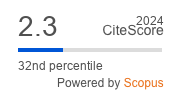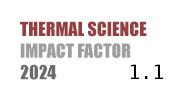THERMAL SCIENCE
International Scientific Journal
TWO-STEP CLUSTER ANALYSIS FOR ENERGY PERFORMANCE INDICATORS COMPARISON
ABSTRACT
Assessing energy performance indicators is important for understanding EU countries’ progress toward achieving sustainability and climate goals, including reducing greenhouse gas emissions and increasing the share of renewable energy. This paper employs two-step cluster analysis using IBM SPSS 26.0 to classify EU member states based on six key energy indicators. The optimal number of clusters was determined using Schwarz’s Bayesian information criterion, ensuring statistical robustness. Four distinct clusters were identified, revealing varying strengths and weaknesses. These insights provide important guidance for policymakers, enabling the development of targeted strategies for improving energy efficiency and sustainability across the EU.
KEYWORDS
PAPER SUBMITTED: 2025-02-05
PAPER REVISED: 2025-03-17
PAPER ACCEPTED: 2025-03-23
PUBLISHED ONLINE: 2025-04-05
THERMAL SCIENCE YEAR
2025, VOLUME
29, ISSUE
Issue 5, PAGES [3453 - 3464]
- ***, European Commission, EU Climate Action and the European Green Deal, Retrieved from: ec.europa.eu/clima/eu-action/european-green-deal_en, 2021
- Knopf, B., et al., The European Renewable Energy Target for 2030 - An Impact Assessment of the Electricity Sector, Energy Policy, 85 (2015), Oct., pp. 50-60
- ***, Eurostat, Renewable Energy Statistics, Retrieved from: ec.europa.eu/eurostat/statistics, 2023
- Maliszewska-Nienartowicz, J., et al., The Energy Transition in the Cities of Copenhagen, Helsinki, and Stockholm: Similar or Different Pathways Towards the EU's 2030 Targets, Urban Climate, 55 (2024), 101887
- ***, International Energy Agency (IEA), Energy Policies of IEA Countries: European Union 2022 Review, Retrieved from: www.iea.org/reports/energy-policies-of-iea-countries-european-union-2022-review, 2022
- Esposito, L., Renewable energy Consumption and per Capita Income: An Empirical Analysis in Finland, Renewable Energy, 209 (2023), June, pp. 558-568
- Simionescu, M., et al., Renewable Energy Consumption-Growth Nexus in European Countries: A Sectoral Approach, Evaluation Review, 47 (2023), 2, pp. 287-319
- Benassi, M., et al., Using two-Step Cluster Analysis and Latent Class Cluster Analysis to Classify the Cognitive Heterogeneity of Cross-Diagnostic Psychiatric Inpatients, Frontiers in Psychology, 11 (2020), 1085
- Aydin, G., The Modelling and Projection of Primary Energy Consumption by The Sources, Energy Sources - Part B, Economics, Planning, and Policy, 10 (2015), 1, pp. 67-74
- Farzaneh, H., Farzaneh, H., Energy Supply Models, Energy Systems Modelling, Principles and Applications, Springer Nature, New York, USA, 2019, pp. 81-105
- Laszlo, T., Ambivalent Changes in the Correlation of Energy Consumption and Economic Growth in the Member States of the European Union (2010-2019), Heliyon, 9 (2023), 3, e14550
- ***, European Commission, Fit for 55: Delivering the EU's 2030 Climate Target on the Way to Climate Neutrality, Retrieved from: ec.europa.eu/commission/presscorner/detail/en/IP_21_3541, 2021
- Ge, F., Mehmood, U., How Natural Resource, Renewable Energy, and Energy Productivity Integrate with Environmental Quality under the Load Capacity Curve in OECD Nations, Journal of Cleaner Production, 459 (2024), 142564
- Marra, A., et al., The Complex Transition: Energy Intensity and CO2 Emissions Amidst Technological and Structural Shifts, Evidence from OECD Countries, Energy Economics, 136 (2024), 107702
- Karasek, A., et al., Assessment of Energy Efficiency in the European Union Countries in 2013 and 2020, Sustainability, 15 (2023), 4, 3414
- Ahmed, M., et al., The K-Means Algorithm: A Comprehensive Survey and Performance Evaluation, Electronics, 9 (2020), 8, 1295
- Boyko, N. I., Tkachyk, O. A., Hierarchical Clustering Algorithm for Dendrogram Construction and Cluster Counting, Informatics and Mathematical Methods in Simulation, 13 (2023), 1-2, pp. 5-15
- Xu, B., Clustering Educational Digital Library Usage Data: Comparisons of Latent Class Analysis and K-Means Algorithms, Utah State University, Logan, Ut., USA, 2011
- Polcyn, J., et al., Factors Influencing the Renewable Energy Consumption in Selected European Countries, Energies, 15 (2021), 1, 108
- Bisello, A., et al., Measuring the Price Premium of Energy Efficiency: A Two-Step Analysis in the Italian Housing Market, Energy and Buildings, 208 (2020), 109670
- Rađenović, Ž., Rajić, M., Assessing Circular Economy Performances of Selected Countries Using MCDM Methods: Promethee vs. CoCoSo, (Eds. U. Tanveer, S. Ishaq, T. Huy, and T. Hoang ), Navigating the Circular Age of a Sustainable Digital Revolution, IGI Global Scientific Publishing, Hershey, Penn., USA, 2024, pp. 59-90

